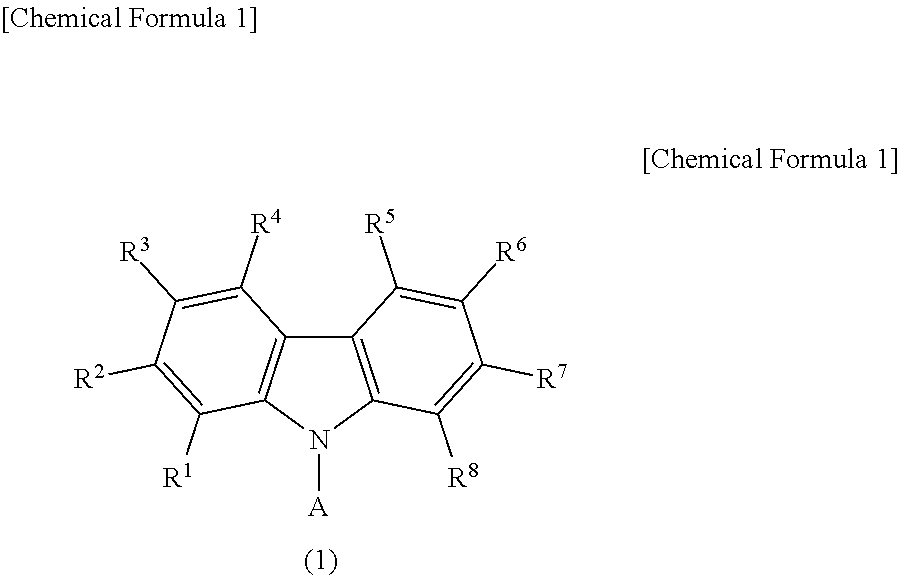Light emitting device material and light emitting device
a technology of light emitting device and material, which is applied in the direction of triarylamine dye, organic chemistry, luminescent composition, etc., can solve the problems of achieving both increased efficiency and prolonged life of the device, and achieve excellent electron blocking properties, high luminance efficiency, and sufficient durable life.
- Summary
- Abstract
- Description
- Claims
- Application Information
AI Technical Summary
Benefits of technology
Problems solved by technology
Method used
Image
Examples
synthesis example 1
Synthesis of Compound [6]
[0117]A mixed solution of 20.9 g of 3-bromocarbazole, 15.0 g of phenylcarbazole-3-boronic acid, 366 mg of palladium acetate, 300 mg of tris(2-methylphenyl)phosphine, 105 ml of a 2M aqueous potassium carbonate solution and 260 ml of dimethoxyethane was refluxed for 6 hours under a nitrogen flow. The solution was cooled to room temperature, and then extracted with 500 ml of toluene. The organic layer was washed with 100 ml of water twice, dried over magnesium sulfate, and then evaporated. The resultant concentrate was purified by silica gel column chromatography and then vacuum-dried to obtain 13.5 g of 9-phenyl-9H,9′H-3,3′-bicarbazole.
[0118]Next, a mixed solution of 20.0 g of 1,3-dibromo-5-chlorobenzene, 19.8 g of phenylboronic acid, 519 mg of bis(triphenylphosphine)palladium(II) dichloride, 217 ml of a 1.5 M aqueous sodium carbonate solution and 370 ml of dimethoxyethane was refluxed for 4 hours under a nitrogen flow. The solution was cooled to room temperat...
synthesis example 2
Synthesis of Compound [156]
[0123]A mixed solution of 20 g of 2-bromonitrobenzene, 17 g of 4-chlorophenylboronic acid, 45 g of tripotassium phosphate, 6.9 g of tetrabutylammonium bromide, 480 mg of palladium acetate and 500 ml of dimethylformamide was heated / stirred at 130° C. for 5 hours under a nitrogen flow. The solution was cooled to room temperature, then poured into 100 ml of water, and extracted with 150 ml of toluene. The organic layer was washed with 100 ml of water three times, dried over magnesium sulfate, and then evaporated. The concentrate was purified by silica gel column chromatography and vacuum-dried to obtain 22 g of 2-(4-chlorophenyl)nitrobenzene.
[0124]Next, a mixed solution of 22 g of 2-(4-chlorophenyl)nitrobenzene, 61 g of triphenylphosphine and 190 ml of o-dichlorobenzene was refluxed for 6 hours under a nitrogen flow. The solution was cooled to room temperature, o-dichlorobenzene was then distilled away under reduced pressure, and the concentrate was purified ...
synthesis example 3
Synthesis of Compound [176]
[0132]A mixed solution of 20.9 g of 3-bromocarbazole, 15.0 g of 9-phenylcarbazole-3-boronic acid, 366 mg of palladium acetate, 300 mg of tris(2-methylphenyl)phosphine, 105 ml of a 2M aqueous potassium carbonate solution and 260 ml of dimethoxyethane was refluxed for 6 hours under a nitrogen flow. The solution was cooled to room temperature, and then extracted with 500 ml of tetrahydrofuran. The organic layer was washed with 100 ml of a saturated saline solution twice, dried over magnesium sulfate, and then evaporated. The resultant concentrate was purified by o-xylene recrystallization and then vacuum-dried to obtain 13.5 g of 9-phenyl-9H,9′H-3,3′-bicarbazole.
[0133]Next, a mixed solution of 10.0 g of 1,3-dibromo-5-chlorobenzene, 9.9 g of phenyl-d5-boronic acid, 130 mg of bis(triphenylphosphine)palladium(II) dichloride, 78 ml of a 2.0 M aqueous sodium carbonate solution and 185 ml of dimethoxyethane was refluxed for 4 hours under a nitrogen flow. The soluti...
PUM
| Property | Measurement | Unit |
|---|---|---|
| resistance | aaaaa | aaaaa |
| resistance | aaaaa | aaaaa |
| resistance | aaaaa | aaaaa |
Abstract
Description
Claims
Application Information
 Login to View More
Login to View More - R&D
- Intellectual Property
- Life Sciences
- Materials
- Tech Scout
- Unparalleled Data Quality
- Higher Quality Content
- 60% Fewer Hallucinations
Browse by: Latest US Patents, China's latest patents, Technical Efficacy Thesaurus, Application Domain, Technology Topic, Popular Technical Reports.
© 2025 PatSnap. All rights reserved.Legal|Privacy policy|Modern Slavery Act Transparency Statement|Sitemap|About US| Contact US: help@patsnap.com



